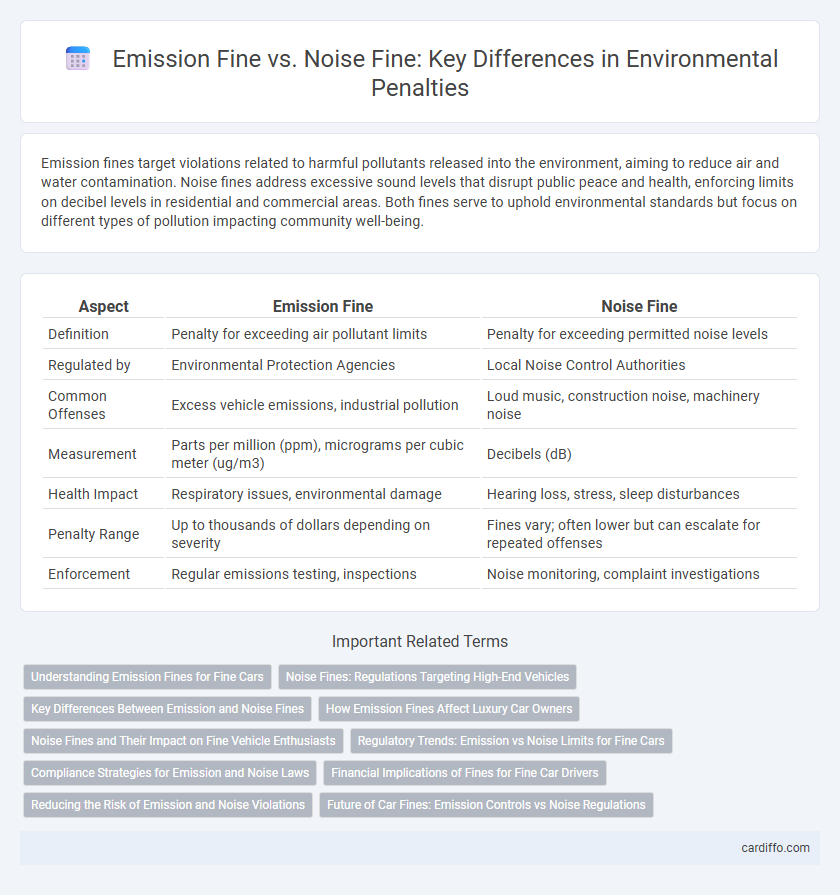Emission fines target violations related to harmful pollutants released into the environment, aiming to reduce air and water contamination. Noise fines address excessive sound levels that disrupt public peace and health, enforcing limits on decibel levels in residential and commercial areas. Both fines serve to uphold environmental standards but focus on different types of pollution impacting community well-being.
Table of Comparison
| Aspect | Emission Fine | Noise Fine |
|---|---|---|
| Definition | Penalty for exceeding air pollutant limits | Penalty for exceeding permitted noise levels |
| Regulated by | Environmental Protection Agencies | Local Noise Control Authorities |
| Common Offenses | Excess vehicle emissions, industrial pollution | Loud music, construction noise, machinery noise |
| Measurement | Parts per million (ppm), micrograms per cubic meter (ug/m3) | Decibels (dB) |
| Health Impact | Respiratory issues, environmental damage | Hearing loss, stress, sleep disturbances |
| Penalty Range | Up to thousands of dollars depending on severity | Fines vary; often lower but can escalate for repeated offenses |
| Enforcement | Regular emissions testing, inspections | Noise monitoring, complaint investigations |
Understanding Emission Fines for Fine Cars
Emission fines for fine cars target excessive pollutants such as nitrogen oxides (NOx) and particulate matter (PM), which directly impact urban air quality and public health. Regulatory bodies enforce strict emission standards using onboard diagnostics and periodic inspections to ensure luxury and performance vehicles comply with environmental guidelines. Understanding emission fines helps owners of fine cars prioritize maintenance of catalytic converters, particulate filters, and engine tuning to avoid costly penalties and contribute to sustainable mobility.
Noise Fines: Regulations Targeting High-End Vehicles
Noise fines specifically target high-end vehicles often equipped with powerful exhaust systems that exceed legal sound limits, posing environmental and community disturbance concerns. Regulatory authorities have implemented stringent decibel thresholds to control noise pollution, with penalties varying across regions but aimed at discouraging modifications that amplify noise emissions. Enforcement includes roadside noise testing and increased monitoring in urban areas to ensure compliance and reduce the impact of excessive vehicle noise on public health.
Key Differences Between Emission and Noise Fines
Emission fines target pollutants released into the air, such as carbon monoxide, nitrogen oxides, and particulate matter, regulated under environmental protection standards to reduce air pollution. Noise fines address violations related to excessive sound levels that disrupt public peace, enforced through local noise ordinances and decibel limits. Key differences include their measurement metrics--emission fines are based on pollutant concentration and type, while noise fines depend on decibel readings and time of occurrence, reflecting distinct environmental and health impacts.
How Emission Fines Affect Luxury Car Owners
Emission fines impose significant financial burdens on luxury car owners due to the higher emissions standards and strict regulatory policies targeting high-performance engines. These fines often lead to increased maintenance costs and the need for costly retrofit technologies to bring vehicles into compliance. Non-compliance can also result in diminished resale value and restrictions on vehicle usage in low-emission zones.
Noise Fines and Their Impact on Fine Vehicle Enthusiasts
Noise fines significantly affect fine vehicle enthusiasts by imposing strict penalties on excessive exhaust noise, which often results from modifications aimed at enhancing performance and sound. Regulations target decibel levels exceeding local limits, leading to fines that can deter owners from customizing their vehicles or force costly adjustments. The impact extends to event organizers and communities, as noise restrictions shape the culture and accessibility of automotive gatherings focused on fine vehicle appreciation.
Regulatory Trends: Emission vs Noise Limits for Fine Cars
Emission regulations for fine cars have become increasingly stringent, with governments worldwide enforcing lower CO2 and particulate matter thresholds to combat climate change. Noise limits are also tightening, especially in urban areas, with maximum decibel levels often set below 70 dB to reduce noise pollution and enhance public health. Regulatory trends indicate a stronger emphasis on emission reduction due to its direct impact on air quality, while noise standards evolve to support quieter, more livable cities.
Compliance Strategies for Emission and Noise Laws
Effective compliance strategies for emission and noise laws involve implementing advanced monitoring systems that continuously track pollutant levels and sound intensity against regulatory standards. Companies should adopt best practices such as using low-emission technologies, soundproofing materials, and conducting regular maintenance to minimize violations and associated fines. Leveraging real-time data analytics enables proactive adjustments, ensuring adherence to both emission and noise limits and reducing the risk of costly penalties.
Financial Implications of Fines for Fine Car Drivers
Emission fines for fine car drivers often result in substantial financial liabilities due to stricter regulations on pollutant levels and vehicle compliance certifications. Noise fines, while impactful, generally incur lower penalties but can vary significantly depending on urban noise ordinances and decibel limits enforced. Both types of fines emphasize the importance of maintaining vehicle standards to avoid costly legal repercussions and potential increases in insurance premiums.
Reducing the Risk of Emission and Noise Violations
Emission fines and noise fines each target specific environmental compliance issues critical to public health and ecological balance. Reducing the risk of emission violations involves implementing advanced filtration systems, adhering to local and international emission standards such as the EPA or EU regulations, and conducting regular air quality monitoring. Similarly, minimizing noise violations requires the use of sound dampening technologies, compliance with permissible noise level regulations set by authorities like OSHA or WHO, and ongoing noise level assessments to ensure community safety and environmental harmony.
Future of Car Fines: Emission Controls vs Noise Regulations
Future car fines will increasingly target emission controls with stricter limits on CO2 and particulate matter to combat climate change and improve air quality. Noise regulations will also tighten, focusing on urban areas to reduce health effects linked to chronic noise pollution, especially from electric and hybrid vehicles that mask engine sounds. Regulatory frameworks are evolving to integrate smart sensors and real-time monitoring for both emissions and noise levels, enhancing enforcement accuracy and public compliance.
Emission fine vs noise fine Infographic

 cardiffo.com
cardiffo.com